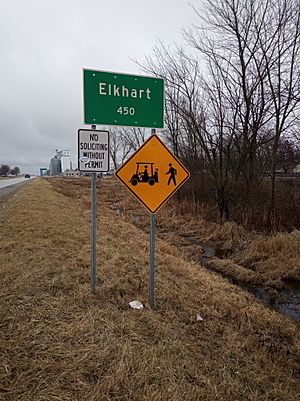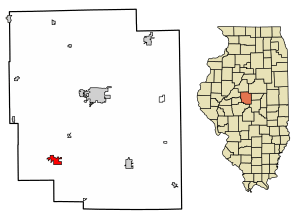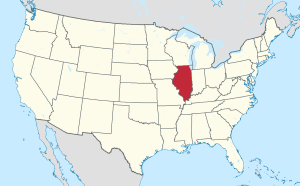Elkhart, Illinois facts for kids
Quick facts for kids
Elkhart, Illinois
|
|
|---|---|

Southern approach to Elkhart
|
|

Location in Logan County, Illinois
|
|

Location of Illinois in the United States
|
|
| Country | United States |
| State | Illinois |
| County | Logan |
| Townships | Elkhart, Hurlbut |
| Area | |
| • Total | 1.95 sq mi (5.05 km2) |
| • Land | 1.94 sq mi (5.03 km2) |
| • Water | 0.01 sq mi (0.02 km2) |
| Elevation | 640 ft (200 m) |
| Population
(2020)
|
|
| • Total | 450 |
| • Density | 231.72/sq mi (89.46/km2) |
| Time zone | UTC−6 (CST) |
| • Summer (DST) | UTC−5 (CDT) |
| ZIP code |
62634
|
| Area code(s) | 217 |
| FIPS code | 17-23269 |
| GNIS ID | 2398805 |
Elkhart is a small village located in Logan County, Illinois, in the United States. In 2020, about 450 people lived there. It is known for its history and a special hill called Elkhart Hill.
Contents
Where is Elkhart Located?
Elkhart is found in the southwestern part of Logan County. It sits across two areas called Elkhart and Hurlbut townships.
How to Get to Elkhart
Interstate 55 is a major highway that runs through the northwest side of the village. You can easily get to Elkhart from Exit 115. This highway connects Elkhart to Lincoln, which is the county seat, about 11 miles northeast. It also leads to Springfield, the state capital, about 20 miles southwest.
Elkhart's Size and Landscape
The village of Elkhart covers about 1.95 square miles (5.05 square kilometers) of land. Most of this area is land, with only a tiny bit of water. A notable feature is Elkhart Hill, which is in the southeast part of the village. This hill rises about 180 feet (55 meters) above the village center and the flat land around it. Its highest point is about 771 feet (235 meters) above sea level.
Who Lives in Elkhart?
The number of people living in Elkhart has changed over the years. Here's a look at how the population has grown and shrunk:
| Historical population | |||
|---|---|---|---|
| Census | Pop. | %± | |
| 1860 | 118 | — | |
| 1870 | 378 | 220.3% | |
| 1880 | 393 | 4.0% | |
| 1890 | 414 | 5.3% | |
| 1900 | 553 | 33.6% | |
| 1910 | 418 | −24.4% | |
| 1920 | 457 | 9.3% | |
| 1930 | 448 | −2.0% | |
| 1940 | 436 | −2.7% | |
| 1950 | 420 | −3.7% | |
| 1960 | 418 | −0.5% | |
| 1970 | 435 | 4.1% | |
| 1980 | 493 | 13.3% | |
| 1990 | 475 | −3.7% | |
| 2000 | 443 | −6.7% | |
| 2010 | 405 | −8.6% | |
| 2020 | 450 | 11.1% | |
| U.S. Decennial Census | |||
Elkhart's Population Today
According to the 2020 United States Census, Elkhart had 450 residents. Most of the people living in Elkhart are White. There are also smaller groups of Asian and people of two or more races. A small number of residents are of Hispanic or Latino background.
Homes and Families in Elkhart
In 2010, there were 176 households in Elkhart. About one-fifth of these homes had children under 18 living there. Many homes were occupied by married couples. Most of the homes in Elkhart are owned by the people who live in them, while a smaller number are rented. The average age of people in Elkhart in 2010 was about 43.5 years old.
Elkhart's Past: A Look at Its History
Elkhart gets its name from "Elkhart Grove," a wooded area. It's said that the grove looked like the heart of an elk. Long ago, before European settlers arrived, a Kickapoo village was located in this grove.
Early Settlers and Important Stops
The first non-Native American settlers came to Elkhart Grove in 1819. James Latham and his family were among them. Their homes became important stops on early travel routes between Springfield and Bloomington. Around 1822, James and Richard Latham built a simple mill powered by horses. This mill was very helpful because before it, settlers had to travel far to get their grain ground.
Famous people, like Abraham Lincoln, often stayed overnight at Elkhart Grove when they were traveling for legal work.
How Elkhart Became a Town
A town was first planned in the 1820s, but it wasn't until the Chicago & Alton railroad came through in 1853 that things really started happening. The first building in the new town was a warehouse, made from an old horse mill.
In 1855, a man named John Shockey officially laid out the town. It was named Elkhart City to tell it apart from Elkhart Hill and Elkhart Grove. That same year, a large hotel was built, and the first general store opened. Many houses were built, and the town grew quickly. The Elkhart City post office opened in 1856.
Growth and Incorporation
For many years, Elkhart was a very busy shipping point for the railroad, partly because of large farms nearby. The town officially became a corporation on February 22, 1861. This meant it could govern itself.
Churches were also built during this time: a Methodist church in 1863, a Catholic church in 1864, and a Christian church in 1867. In 1883, the post office name was shortened to just Elkhart. A new train station was built in 1888.
Fires and Rebuilding
Like many towns back then, Elkhart faced challenges from fires.
- In 1889, lightning caused a fire that destroyed many of Elkhart's businesses and one home.
- In 1891, the home of Governor Richard J. Oglesby burned down. He rebuilt a new home, which he called Oglehurst, and lived there until he passed away in 1899.
In 1885, Elkhart changed its legal status to a village. A new library building was built in 1904, given as a gift by the Gillett family. Elkhart was also a stop on the Illinois Traction System, an electric train line that ran from Peoria to St. Louis from 1904 until the 1950s.
Famous People from Elkhart
Elkhart has been home to several notable individuals:
- Adam Bogardus: A world champion in trap shooting during the 1800s.
- Richard J. Oglesby: A governor of Illinois in the 1800s. He lived and died in Elkhart.
- Jake Stahl: A professional baseball player who played first base and managed teams like the Boston Red Sox. He was born in Elkhart.
- Tommy Thompson: Another professional baseball player who played outfield for teams like the Boston Braves. He was also born in Elkhart.
Images for kids
See also
 In Spanish: Elkhart (Illinois) para niños
In Spanish: Elkhart (Illinois) para niños




